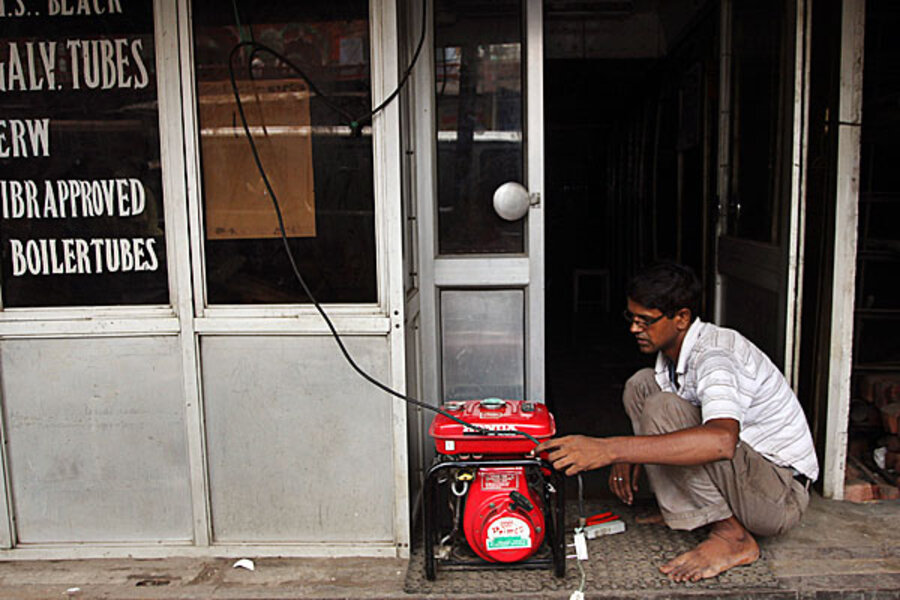World's biggest blackout: 620 million people without power in India
Loading...
| New Delhi
India's energy crisis cascaded over half the country Tuesday when three of its regional grids collapsed, leaving 620 million people without government-supplied electricity for several hours in, by far, the world's biggest-ever blackout.
Hundreds of trains stalled across the country and traffic lights went out, causing widespread traffic jams in New Delhi. Electric crematoria stopped operating, some with bodies half burnt, power officials said. Emergency workers rushed generators to coal mines to rescue miners trapped underground.
The massive failure — a day after a similar, but smaller power failure — has raised serious concerns about India's outdated infrastructure and the government's inability to meet its huge appetite for energy as the country aspires to become a regional economic superpower.
IN PICTURES: India Power Outage
Power Minister Sushil Kumar Shinde blamed the new crisis on states taking more than their allotted share of electricity.
"Everyone overdraws from the grid. Just this morning I held a meeting with power officials from the states and I gave directions that states that overdraw should be punished. We have given instructions that their power supply could be cut," he told reporters.
The new power failure affected 620 million people across 20 of India's 28 states — about double the population of the United States. The blackout was unusual in its reach, stretching from the border with Myanmar in the northeast to the Pakistani border about 3,000 kilometers (1,870 miles) away. Its impact, however, was softened by Indians' familiarity with frequent blackouts and the widespread use of backup generators for major businesses and key facilities such as hospitals and airports.
Shinde later said power was fully restored in the northeast grid four hours after it went down, and that the north grid had 45 percent power and the east grid 35 percent. R.N. Nayak, chairman of Power Grid Corp., which runs the nation's power system, said he expected to have full power later in the evening.
The outages came just a day after India's northern power grid collapsed for several hours. Indian officials managed to restore power several hours later, but at 1:05 p.m. Tuesday the northern grid collapsed again, said Shailendre Dubey, an official at the Uttar Pradesh Power Corp. in India's largest state. About the same time, the eastern grid failed and then the northeastern grid followed, energy officials in those regions said. The grids serve more than half India's population.
In West Bengal, express trains and local electric trains were stopped at stations across the state of West Bengal on the eastern grid. Crowds of people thronged the stations, waiting for any transport to take them to their destinations.
Chief Minister Mamata Banerjee said it would take at least 10 to 12 hours to restore power and asked office workers to go home.
"The situation is very grave. We are doing everything to restore power," West Bengal Power Minister Manish Gupta said.
New Delhi's Metro rail system, which serves about 1.8 million people a day, immediately shut down for the second day in a row. Police said they managed to evacuate Delhi's busy Rajiv Chowk station in under half an hour before closing the shutters.
S.K. Jain, 54, said he was on his way to file his income tax return when the Metro closed and now would almost certainly miss the deadline.
Tuesday's blackout eclipsed yesterday's in India, which covered territory including 370 million people. The third largest blackout affected 100 million people in Indonesia in 2005, according to reports by The Associated Press.
India's demand for electricity has soared along with its economy in recent years, but utilities have been unable to meet the growing needs. India's Central Electricity Authority reported power deficits of more than 8 percent in recent months.
In addition, vast amounts of power are pirated through unauthorized wiring that taps into the electrical system.
The power deficit was worsened by a weak monsoon that lowered hydroelectric generation and kept temperatures higher, further increasing electricity usage as people seek to cool off.
But any connection to the grid remains a luxury for many. One-third of India's households do not even have electricity to power a light bulb, according to last year's census.
IN PICTURES: India Power Outage
------
Associated Press writer Nasr ul Hadi contributed to this report from New Delhi and Prasanta Pal contributed from Kolkata.





